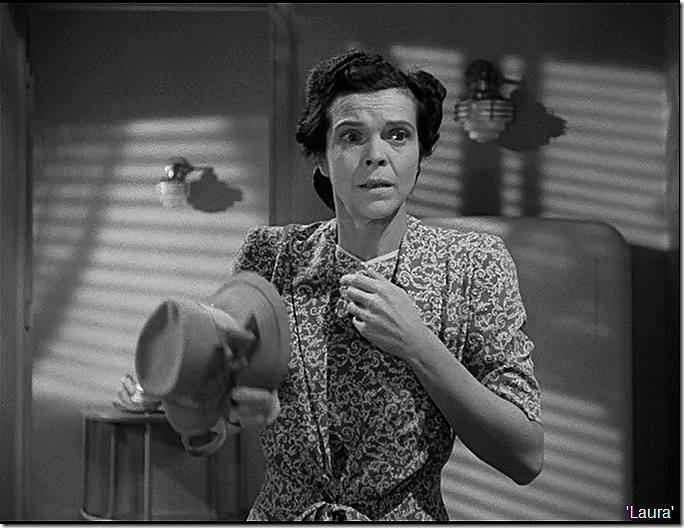
Dorothy Adams as Bessie Clary, Laura Hunt’s maid, in “Laura.”
In case you just tuned in, I’m using Louella Parsons’ May 15, 1944, item on Rouben Mamoulian being replaced as the director of “Laura” to take a meandering look at the making of the film, which was released in Los Angeles in November 1944. Previous posts have examined the writing career of “Laura” novelist Vera Caspary and the state of the detective story in 1941, when she was writing the novel. We also explored some of the locations Caspary used in the book.
In the next few posts I’m going to look at the characters as portrayed in the novel, starting with the smaller roles and working up to Waldo Lydecker (played by Clifton Webb in the film). Although the book and film are titled “Laura,” Waldo is the most important character and the one who required the most work, as Caspary noted in her autobiography, “The Secrets of Grown-Ups.”
In this post we will look at the role of Bessie Clary (played by Dorothy Adams in the film), who has worked as a maid for Laura Hunt (played by Gene Tierney) for several years.
Spoilers ahead
In the film, we are left to infer that Bessie is Irish, but her heritage is emphasized in Caspary’s novel to the heighten her underlying animosity toward Detective Mark McPherson (played by Dana Andrews in the film), who is a Scotsman. In the novel, Mark’s Scottish ancestry is underscored repeatedly, mostly by Waldo, who fires off barbs about the Scots being stoic, melancholy skinflints with a thirst for whiskey.
In the novel, Bessie first approaches Mark at Laura’s funeral in a scene that was scrapped in the screen adaptation, although some of the dialogue survives.
In the opening section, using Waldo’s point of view, Caspary writes (Page 52):
As [Mark] descended from the balcony and joined the slowly moving mass, he noted a hand, gloved in black, signaling him. Bessie Clary pushed her way through the crowd.
”I got something to tell you, Mr. McPherson.”
He took her arm. “Shall we go upstairs where it’s quiet or does this place depress you?”
”If you wouldn’t mind, we could go back to the flat,” Bessie suggested. “It’s up there, what I got to show you.”
Mark had his car. Bessie sat beside him primly, black gloved hands folded in the lap of her black silk dress. (Note the contrast in her outfit with what Adams is wearing in the film).
“It’s hot enough to kill a cat,” she said by way of making conversation.
”What have you got to tell me?”
”You needn’t to yell at me. I ain’t afraid of cops, or dicks either.” She drew out her best handkerchief and blew such a clarion note that her nose seemed an instrument fashioned for the purpose of sounding defiance. “I was brought up to spit whenever I saw one.”
”I was brought up to hate the Irish,” Mark observed,” but I’m a grown man now. I haven’t asked for love, Miss Clary. What is it you want to tell me?”
”You won’t get on my good side by that Miss Clary stuff either. Bessie’s my name, I’m a domestic and I got nothing to be ashamed of.”
As in the movie, Bessie reveals that she found a bottle of cheap liquor — “Three Horses Bourbon, a brand favored by frugal tipplers” (Page 55) – in Laura’s bedroom, but in the novel we learn that there were two glasses on a table by the bed.
“Cops got dirty minds,” Bessie says in explaining why she wiped off the fingerprints and put everything away. “I don’t want the whole world thinking she was the kind that got drunk with a fellow in her bedroom, God rest her soul.”
Already infatuated with Laura after scrutinizing her apartment, including her rather chaste bedroom, Mark reacts angrily (Page 56).
Never before had the stern young Scot known a woman in this fashion. Just as her library had revealed the quality of her mind, her boudoir had yielded the secrets of feminine personality.
He did not like to think of her drinking with a man in her bedroom like a cutie in a hotel.
Bessie serves another function in the novel and that is to encourage Laura’s romantic interest in Mark (Page 187-188).
This time using Laura’s point of view, Caspary writes:
“He’s a man,” Bessie said abruptly.
Bessie’s attitudes are high 10th Avenue; she is off the sidewalks of New York and as unrelenting as any snob that came out of Murray’ Hill’s stone mansions. I had met her brothers, outspoken and opinionated workingmen whose black and white rules of virtue my intellectuals and advertising executives could never satisfy.
“A man,” Bessie said. “Most of them are big babies or old women. For once, even if he’s a dick, you’ve met a man.” And then completely in the groove of man-worship, added, “Guess I’ll bake a chocolate cake.”
To be continued.


I have to say it tickles me that both you and Wikipedia make the same mistake in labeling Laura a “Classic Film Noir”. Laura is simply a mystery crime movie, totally without the classic noir trope wherein the lead character is caught in a downward spiral of disaster due either to bad choices (European Existentialism) or bad luck. It can have no romantic happy ending. Double Indemnity is, of course, the classic film noir, and there are plenty of similar examples. If you and Wikipedia want to say that I am nitpicking and unreasonably narrow in identifying the roots and examples of Film Noir, so be it. But if we are going to acknowledge that the term defines something, then it has to be something different than the standard Whodunit, which Laura, let’s face it, is a good and entertaining example of.
LikeLike